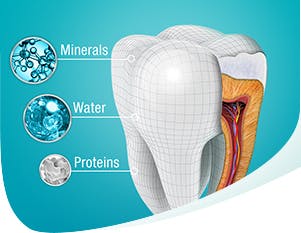Cavity Symptoms: How Do I Know if I Have One?
The human body has lots of way of letting us know when something isn’t right. Our muscles may remind us of a strenuous activity by being stiff and sore. A bruise indicates where we bumped into a table. And an insect bite is characterized by raised and itchy skin. Cavities make their presence known too—but we may not recognize the signs. Learn about different cavity symptoms so you can get to the dentist before it becomes a larger issue.
What Are the Symptoms of a Cavity?
A cavity is the result of tooth decay brought on by acids created from bacteria in your mouth attacking the enamel of your teeth.1 Your mouth is full of naturally occurring bacteria. When bacteria comes into contact with the sugars and starches from what you eat and drink, they form an acid.1 Plaque can stick to your teeth and cause the protective enamel on your teeth to weaken due to loss of minerals.1,2 You may notice a white spot on one or more of your teeth when this happens. This is the first sign of tooth decay.1 This spot may weaken further and become a cavity if it’s left untreated.
Early tooth decay symptoms may be minimal once the cavity develops. As tooth decay advances you should pay close attention to these telltale symptoms:1,2
- Toothaches
- Tooth sensitivity
- Pain when eating foods that are overly hot, cold or sweet
- Visible pits or holes in your teeth
If left untreated, a cavity can become infected. This may lead to symptoms such as: 1
- An abscess
- Facial swelling
- Fever
It’s important to be aware of these symptoms so that you can seek timely treatment from your dentist.
How Are Cavities Treated?
Only your dentist can truly diagnose if what you’re experiencing is a cavity. A routine dental exam may indicate where there is some softening of the enamel of your teeth and an x-ray may show other damage that cannot be seen by the naked eye.2
Treatment for your cavity may depend on how much decay and damage there is to your tooth. If no hole has formed in your tooth, your dentist may apply a fluoride treatment directly to the affected area to reverse the damage.1
In most cases, a filling is all that is needed. Your dentist will drill out the decayed part of your tooth and replace it with a resin filling that matches the appearance of your tooth.2 If the damage is more extensive and the structure of the tooth is compromised or your tooth’s pulp is exposed to bacteria, your dentist may opt for a crown or a root canal to address the cavity.2
Addressing your symptoms as soon as they appear will go a long way toward keeping you comfortable and minimizing pain, damage and cost.2 It’s important to be aware of cavity symptoms so that you can take care of them quickly and prevent any further issues from developing.
How to Prevent Cavities
Proper oral hygiene can prevent cavities. Proper oral hygiene includes:2
- Professional dental cleanings every 6 months
- Brushing your teeth at least twice a day.
- Flossing at least once per day
Your eating habits can also help prevent cavities. Reducing snacking prevents sugars from accumulating in your mouth. Eat chewy or sticky snacks like dried fruit with a meal instead. You should also avoid drinking sugary drinks or mints. It’s important to brush your teeth after eating.2 Use a mouthwash or toothpaste with fluoride like Pronamel Intensive Enamel Repair Extra Fresh Toothpaste. Fluoride can prevent tooth decay.2
Tobacco products can lead to tooth decay.1 Even smokeless tobacco can lead to tooth decay. Stop using tobacco products to prevent tooth decay.
Taking care of your teeth is important. Explore all Pronamel oral care products to protect your teeth from cavities.
Source Citations:
- Tooth Decay. National Institute of Dental and Craniofacial Research. https://www.nidcr.nih.gov/health-info/tooth-decay#symptoms. Accessed 5/23/2023.
- Dental cavities. Medline Plus. https://medlineplus.gov/ency/article/001055.htm. Accessed 5/23/2023.




